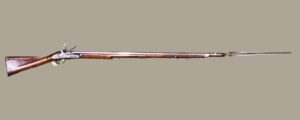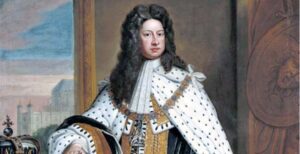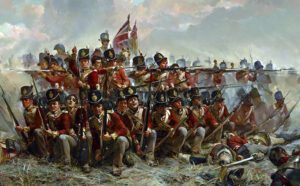
Brown Bess is not a reference to a woman but is the name given to the gun that won the British Empire. Nobody knows for sure why the name was adopted by the troops, but it still is the name we all know. The Brown Bess musket was introduced early in the eighteenth century and was the British military’s principal longarm until the introduction of a percussion cap smoothbore musket in 1838. The Brown Bess was used in early wars in the American colonies, by both sides in the War for American Independence, in the conquest of India and in the Napoleonic wars. Bess was altered several times to meet changing demands, but its basic design remained intact.
The long development of infantry firearms was made possible by the invention of gunpowder. The earliest proved reference to gunpowder was in China in 808 AD. Gunpowder was initially used for medicinal purposes and fireworks. The first military application was before 1000 AD when it was used for fire arrows.
During the first half of the Twelfth Century, the Chinese introduced the “Fire Lance” which was a spear with a gunpowder charge in a bamboo tube attached to the end. Initially, it would shoot out a flame much like a miniature flame thrower, but later it was used to propel broken pottery and iron pellets.

The Chinese probably developed the “hand cannon” about 1280 AD, which was the first weapon we would consider to be a “gun.” It was a cast bronze (later iron) tube with a bore of about one inch and a bulbous base to withstand the expansion of powder ignition. There was a touch hole for igniting the powder charge. These unwieldy weapons were heavy, weighing at least ten pounds. They were often deployed with the fire lance, which made a terrifying combination.
Technology developed slowly in China and Eurasia, and it took almost 400 years to work its way to Europe. The pace of European firearms development soon surpassed the Far East.
During the early fourteenth century European armies were armed with grenades and an improved version of hand cannons. As previously noted, hand cannons were unwieldly and heavy. Reloading was slow and difficult, and the presence of unprotected gunpowder and lighting devices was dangerous.
The arquebus was the first technological advance after the hand cannon. It was introduced during the early fifteenth century and had a longer straight barrel, and an external powder pan that held the powder to ignite the main charge in the barrel. The powder in the pan was ignited by a fuse that was held by the soldier. The fuse was a cord of hemp or flax that had been chemically treated to burn (smolder) slowly. The arquebus required both hands to be fired and was usually mounted on a stand to permit priming and firing.
Even though the arquebus was a vast improvement from hand cannons, it was dangerous because the soldier had to carry substantial amounts of powder and the presence of the burning fuse sometimes resulted in unintended ignition which injured the operator and those close to him. Also, during rain if the fuse and the powder got wet, they became useless.
Later in the fifteenth century the matchlock was invented. It was the first gun with a trigger and was the first true shoulder fired firearm. The trigger activated a mechanical device that moved a fuse to the powder pan to ignite the powder. The matchlock was a major improvement but was still usually useless in the rain.
Large numbers of the arquebus and the matchlock were adopted by many armies but did not result in significant new tactics. Firearms were often deployed among the pikemen in fighting squares to strengthen their defense against cavalry charges. Also during this time, volley fire was pioneered by the Chinese and Ottomans. Firearms were making war more organized and more lethal.
The introduction of the wheellock in the early sixteenth century was a gigantic step forward in the design of firearms. It was the first self-igniting gun in history. It achieved this with an elaborate spring-loaded mechanism that would grind a toothed cog against a piece of pyrite to generate sparks – like a modern Zippo lighter. Once loaded and wound, the wheellock could easily be fired with one hand. It seldom fired accidentally so was safer than earlier designs.
Unfortunately, the wheellock required enormous skill and cost to manufacture. This made it impractical for most military use, but it was another technological step in the development of military firearms.
The snaphance lock was an early version of the flintlock and was the first to be designated a “musket.” (Musket is defined as an infantryman’s light gun with a long barrel, typically smooth-bored, muzzleloading and fired from the shoulder.) The snaphance lock spanned the time between the wheellock and the later improved flintlock. It was heavier than the later flintlock, and the technology was much more crude. This gun was developed in the mid-sixteenth century and became popular with many armies, particularly in the pistol version. However, it had many shortcomings. It did not have a half-cock feature which made the hammer more likely to accidentally discharge the weapon when the hammer was being cocked or uncocked. Also, the weight of this gun made it unwieldly.
The early seventeenth century saw the introduction of the improved flintlock musket. The flintlock was lighter, less prone to misfires, and had a much faster reloading rate. By the Battle of Blenheim in 1704 flintlocks were becoming the dominant infantry weapon on European battlefields. The mechanics of the operation of a flintlock are as follows: squeezing the trigger causes the hammer, which holds a flint, to strike an upright member (frizzen) which shaves off iron to create sparks. The hammer’s blow also snaps the frizzen back to expose the gunpowder in the pan. The pan’s gunpowder ignites, and it flashes through a small hole in the side of the barrel to ignite the gunpowder inside the barrel.
All versions of Infantry firearms were being manufactured in many countries and the quality varied considerably. Typically, armies did not have a standard firearm and combatants usually provided their own weapon. There were no significant firearm tactics. This was a transition period, and most battles were being fought using old tactics, but with guns. Battle was still a melee of individual fights.

The reign of British King William III (William of Orange) began in 1689 when he and his wife replaced the deposed James II. William brought foreign troops and a mixture of foreign weapons to Britain. Especially in times of war, such a variety of weapons is a logistics nightmare. Foreign arms still dominated in the British military when the Reign of George I began on 1 August 1714. George I recognized that Britain’s army needed standardization and organization.
In 1715 George I’s government created a “Board of Ordnance” to set weapon standards and manufacture. These changes did not happen quickly, but it was the time when the Brown Bess gradually emerged as the “King’s Arm.”
Britain adopted this improved flintlock with the half-cock safety feature. It was sturdier than its predecessors and better withstood battle conditions and soldier abuse. It was designed for a socket bayonet that attached around the barrel. Previously, bayonets were inserted into the weapon’s bore and had to be removed prior to firing. The bayonet eliminated the need for pikemen and transformed the infantry into the most important branch of the early modern military.
The term “Brown Bess” first appeared in print in 1785 but had been used by the troops since at least 1760. The origin of the name is unknown but there are many theories and opinions. None of those “hold water” so the origin is likely to remain unknown indefinitely.
There were three major versions (patterns) of the Brown Bess musket, and each version had several variants. They all weighed between nine and 11 pounds.
The Long Land Pattern was 62 inches long with a 46-inch barrel. Production continued into 1790.
The Short Land Pattern was first introduced in 1768 and was widely used during the American Revolution. With a length of 58 inches and a 42-inch barrel it was in service in the last years of the 18th Century.
A Short Land New Pattern version was introduced in 1812 for light infantry and featured a reinforced hammer.
The India Pattern was 55 inches long and had a 39-inch barrel. It was introduced in large numbers after 1793. A naval variant had a 37-inch barrel. The India Pattern was originally an economy version produced for the British East India Company. It would end up becoming the most widely used British firearm during the Napoleonic Wars (1803-1815). More than a million were manufactured before production ended. In addition to being Britain’s principal infantry weapon, it was exported to the King’s allies on the European Continent.
Brown Bess pre-dated the era of standardized mass production, and its barrels were manufactured in a less-than-consistent cottage industry. The barrel bores were not consistent which degraded the accuracy of many muskets.
Early metal lock plates were made in a small district in Birmingham by inter-related families. Metal parts were mated to stocks and proofed in the Tower of London. Lock plates were stamped “Tower” and “GR” above an etched crown. GR were the initials for Georgius Rex, the Latin form of King George.
The adoption of the Brown Bess revolutionized British logistics because all infantrymen were issued one basic long arm. This meant British Supply had to stock only one weapon and spare parts. Only one mixture of gunpowder had to be stocked. Lead was provided to the troops so they could cast their own balls. These lead balls caused terrible wounds because the soft lead expanded and fragmented upon impact. Numerous lead particles pierced the body. If the man made it to medical treatment, it was nearly impossible for the medic to remove all the lead in a gunshot wound.
Bess could theoretically hit a target at 650 yards at a five-degree elevation. However, its actual effective range was far shorter. British Colonel George Hanger wrote the following in1814: “A musket that is not exceedingly ill-bored may strike the figure of a man at 80 yards. Perhaps even a hundred. But as to firing at a man at 200 yards with a common musket, you may as well fire at the moon with the same hope of hitting your target.”
During the British retreat from the battle at Concord, Massachusetts on 19 April 1775, their troops were constantly sniped at by colonial militiamen who were firing at ranges of 30 yards or less. The militia were able to stabilize their muskets on features such as stone walls and were shooting slightly downward, but only one ball in 400 struck a target. This was typical of the era.

To compensate for the poor accuracy of their muskets, the British wisely chose to concentrate their musket fire into a smaller area by using a . Lines (echelons) of men slowly marched shoulder-to-shoulder towards the enemy. When they reached the effective range of their muskets (40-60 yards) they stopped. On command, the leading line leveled their muskets in unison and fired on command. They then knelt to reload while the line behind them fired. Their reload rate was 15 to 20 seconds. If the volley fire staggered or confused the enemy, they would continue this slow march forward and sweep the enemy from the field. If the enemy stood firm, they would continue to advance shoulder-to-shoulder with bayonets fixed and engage in hand-to-hand fighting.

Even using linear tactics and volley fire, most balls did not hit their target. Volleys were usually too high because most soldiers did not take recoil into consideration. Officers and NCOs were constantly admonishing the men to aim low, but whole stands of trees behind enemy lines were often reduced to stumps.
The black powder used by the muskets was very dirty and musket fire resulted in thick clouds of foul-smelling smoke. After a few volleys visibility was often reduced to a few feet and soldiers had to fire at enemy muzzle flashes.
The 18 June 1815 Battle of Waterloo was a typical bloody battle of that era. This battle pitted Napoleon’s French Army against a coalition commanded by Britain’s Duke of Wellington and Prussian General Blucher. The battle did not begin until 11:30 AM and ended before dusk. During that brief time, 55,000 men were killed, wounded, or missing. Despite the number of casualties, it is estimated that less than one percent of balls fired hit a target.
Other armies, including the American Continental Army, adopted linear tactics and volley fire. The Continentals were armed Brown Bess muskets and had adopted the British tactics, The Americans had been British subjects and had served in British wars that were fought in North America. The Brown Bess was widely respected and readily available in large numbers. Most able-bodied men in the American colonies were required to be armed for militia duty and most of them were armed with a Brown Bess.
Even when opposing armies used linear tactics and volley fire, the British still held the advantage. This advantage was reloading speed which was the result of excellent training. As noted earlier, the British infantryman could reload every 15 to 20 seconds. Even though this speed was reduced during the heat of battle, it was usually far superior to others.
With the exception of the American colonies, the British went on to win an empire using the Brown Bess and linear tactics. The British Empire eventually encompassed over a quarter of the earth’s population and brought great wealth to Britain. The statement that “the Sun never sets on the British Empire” was true. The British managed to hold this empire until the decade following World War II when anti-colonial sentiment swept the world.
Brown Bess was the British infantryman’s long gun from 1722 to 1838 when it was replaced with a percussion cap smoothbore musket. It had served in many wars all over the world by the British and it was usually victorious. Even after retirement in 1838, the old girl saw service in other armies. Bess was used in the Texas Revolution of 1836, and the Mexican-American War of 1846-1848. She saw service in the First Opium War of 1839-1842, the Indian Rebellion of 1857 and in the 1879 Zulu War.
A British veteran corporal on the eve of the Battle of Waterloo reportedly stated to another soldier: “You can pray to Jesus all you like, but the only religion I need is my Brown Bess and my bayonet.”
The author Rudyard Kipling was the poet of Empire, and he wrote: “If we as Britons have reason to bless any arms-save our Mother’s-those arms are Brown Bess….”
